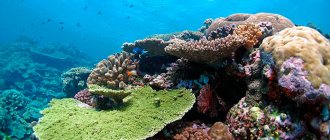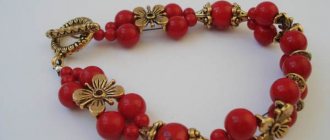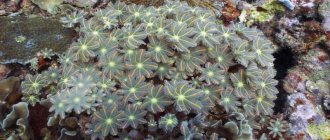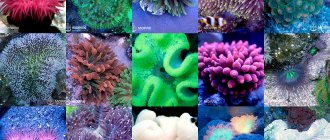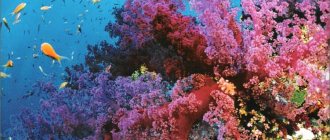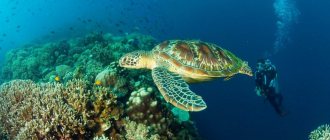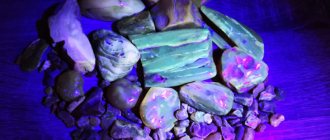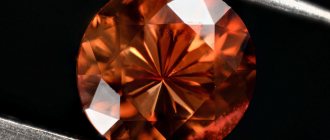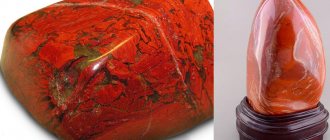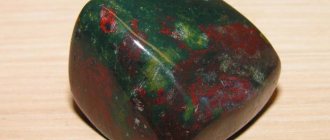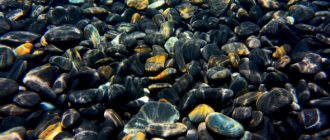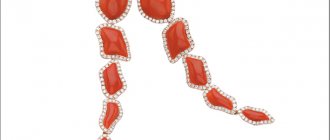| Category | Precious minerals of organic origin |
| Title in English | Coral |
| Formula | CaCO3 |
| Group | Coral group |
| Color | Red, Pink, Orange, Brown, White, Black |
| Stroke color | To be confirmed |
| Shine | Waxy, Dull, Matte |
| Transparency | To be confirmed |
| singonia | Amorphous |
| Hardness | 3 — 6 |
| Cleavage | Absent |
| Density, g/cm³ | 1,3 — 2,7 |
| Kink | Wrong, splintered |
| origin of name | According to the main version, the term “coral” goes back to the ancient Greek word κοράλιον, which translates as “hardened calcareous skeleton of coral animals.” However, it is worth clarifying that the ancient Greeks also borrowed this word from the ancient Romans, who spoke Latin - corallium. |
Corals are the components of the skeletons of coral polyp colonies. Their large accumulations form reefs and even islands. Under the best conditions, corals do not grow more than 1 cm per year, which is why reef formation occurs over hundreds and thousands of years.
Coral deposits
Corals live in seas with a water temperature of at least 21°C, where they form their “bushes” at depths of 3 to 5 m.
After harvesting, coral branches are cleared of soft parts and sorted by quality, branch thickness, color and defects. — Advertising —
Today, corals are most actively mined in the Mediterranean Sea, near the coasts of Algeria, Tunisia, and Italy. On the rocky bottom under the rocks there grow reefs with branches facing down. Corals from Algeria are considered the most valuable, due to the fact that they produce the least amount of waste during processing. Expensive black Akbar corals grow along the coast of India, in the Red Sea basin, next to the Malaysian archipelago. Not far from Africa and the Samoan Islands, red, purple and blue Akori corals are found. Japan is known for its dark red "Moro" corals and pale pink "Bokeh" corals.
Cozy textures
Limited Edition carpets attract attention at first sight. And you feel the love for the natural materials, colors and textures that lie behind them. Pure craftsmanship, handmade, distinctive design, Belgian quality . The factory offers freedom of choice not only in color, but also in the shape, size and material of the future carpet.
In the photo: bright carpet Limited Edition Mystic .
History of coral
The name "coral" has German and Polish roots, which in turn go back to ancient Greek origins.
They have been known to man for quite a long time. In Ancient Greece, pink corals were considered a source of immortality and happiness. And in Europe in the Middle Ages, corals symbolized modesty and purity. It was believed that they add wisdom and intelligence, develop logic and intuition, and enhance memory. Talismans with corals were used to protect against various troubles, in difficult situations, and also to protect oneself from evil forces.
Today, corals remain popular in jewelry and decorative items. Corals are found both in tropical seas and oceans and in the cold Atlantic Ocean. To date, scientists have described such varieties of corals as fan-shaped and tree-shaped, as well as subspecies of different color characteristics.
Who is suitable according to their zodiac sign?
According to astrologers, a fossilized polyp suits absolutely everyone. But since this is a marine formation, he still gives preference more to water signs - Pisces, Scorpios, Cancers. Here man and coral will find complete harmony and interaction.
He also has considerable influence on Sagittarius, Virgo, Aries. The mineral will help to “curb” a strong temperament, calm too violent energy and soften the sharp edges in character.
For everyone else, coral is considered a universal talisman. It will not cause harm even if you wear it daily.
Physicochemical characteristics of coral
Coral is made up of hard minerals such as aragonite and calcite. Its chemical composition is represented by calcium and magnesium carbonates, as well as iron oxides. Typically, corals contain approximately 1% organic matter. Only in Indian black corals do organic components predominate.
The hardness of corals on the Mohs scale is 3.5-4. Specific gravity 2.6-2.7 g/cm3. Untreated corals have a matte surface, with spots, cracks and pores. When polished, a glassy shine appears. The smoother the color and the fewer defects natural coral has, the more valuable it is. A characteristic property of corals is their susceptibility to high temperatures and acids.
Description
Coral is the fossilized skeletons of invertebrate polyps that form entire reefs or even islands called atolls in sea waters. Sometimes such natural wonders take thousands of years to form, striking with their splendor and beauty. To have an approximate idea of how quickly an entire atoll can form, you need to understand that coral grows on average 1 cm per year. Yes, this is not so much, but if we take as an example some remote island where no human has set foot, then it is not difficult to imagine what kind of beauty will form there in 10 or 15 years.
For example, there is the largest reef located on the coast of Australia. Its length is 2200 km!
Coral consists primarily of calcium with various impurities. The formation also includes organic substances. Depending on their number, the coral will be painted in different shades. For example, black coral consists only of organic matter. This type of coral is included in the Red Book, and its extraction is strictly prohibited by law.
All polyps are conventionally divided into three groups:
- noble - used in jewelry;
- root - resembling small bushes;
- foamy - consisting of soft and hardened parts.
In the scientific sense, it is not considered a stone. It can be called a mineral, but definitely not a gem. However, this does not prevent the formation from being used as an insert in jewelry. Coral is quite easy to process and polish, which makes it possible to use it in creating jewelry. Its density is from 2.6 to 2.7, hardness is about 3.75.
The cost of natural coral often exceeds the cost of diamonds if we are talking about high-quality formations with a uniform shade, without defects, cracks and streaks.
In its raw form, coral has a matte sheen, but after polishing it becomes glassy and waxy. The mineral is not resistant to high temperatures and various chemical influences.
As for the shades of the mineral, in total there are about 350 of them! The most popular shades are:
- pink;
- powdery;
- red.
Purple and blue coral are also found in the waters of the seas, but they are so rare that it is quite difficult to see them on store shelves. In addition, the cost of such polyps is quite high, so not everyone can afford such a purchase.
Surprisingly, but true: corals have the same “age” rings as trees.
As for the conditions for the formation of corals, they grow exclusively in warm waters, where the temperature does not drop below 21°C. As a rule, these are the depths of the Red and Mediterranean Seas. Typically, coral bushes form at great depths - at least three meters. They have a fairly strong and solid base, which allows them to protect themselves from fast currents or storms.
In some countries, the legislation prohibits the export of corals from the country. In this way, the government is trying to protect polyps from destruction. Such states include, for example, Egypt and Thailand, where tourists brutally destroy sea reefs every year. At best, you will pay a hefty fine. At worst, you'll end up in jail.
The magical properties of coral
Coral amulets attract good luck to their owner, endow him with the gift of foresight, and have a good effect on mental state and logical thinking.
They are believed to protect against the evil eye and lightning. In addition, corals are an excellent remedy for fatigue and for increasing vitality. They relieve tension, apprehensions, fears, depression, and give prudence. The positive effect of coral on the psyche is reflected in the neutralization of such negative states as anger and envy.
Coral amulets are considered the best protectors against bad people, and they are often given to children. Coral also protects travelers from hurricanes and storms, and helps them return home safely.
Energy of nature
Coral color is able to give off warmth. By placing coral-colored elements in the interior, you can add warmth to the atmosphere. The stylish modular sofa from designer Patricia Urquiola in coral color offers an unprecedented number of different configurations, possible sizes and shapes, which allows it to fit brilliantly into various interiors. The frame of the model is made of wood, and the base is made of stainless steel:
In the photo: designer sofa Moroso Lowland .
The outgoing and energetic nature of Living Coral encourages light-heartedness. Symbolizing our innate need for joy, coral represents the desire for playful self-expression.
The healing properties of coral
The healing qualities of coral are associated with its composition, which is represented by a large amount of calcium and many important trace elements, such as iodine.
Coral powder has long been used in folk medicine to restore the skeletal system and treat thyroid diseases.
Preparations based on corals increase tone, improve memory, and support the cardiovascular and nervous systems. With their help, diseases of the liver, intestines, and stomach ulcers are treated. In addition, they relieve headaches, gout attacks and sore throats.
Romantic mood
The high quality of Bolzan materials, combined with wide possibilities for personalization and careful execution, has made the Bolzan a popular choice among European and Russian buyers. A romantic style bed with a high headboard and flowing canopy creates more airy space. At your request, it is possible to make it in textile and leather form:
Pictured: Bolzan Fuji canopy bed.
The process of choosing the color of the year requires careful analysis. Pantone specialists comb the world in search of new trends. This includes the entertainment industry and films, exhibitions and works of new artists, fashion, all areas of design, popular travel destinations. Trends can also be related to new technologies, materials, social media and even upcoming sporting events that are attracting worldwide attention.
Let us remind you that the color of 2022 according to Pantone was ultraviolet. We talked about the role of this shade in the interior .
Branches of application of coral
The coral “tree” basically contains a stump with branches.
Not all of them are suitable for jewelry making, as they can be thin and dense. The processing of suitable parts of coral is done in an oval, ball or cabochon. In the past, talismans and amulets made from coral were very popular. Later, beads, rings, earrings, necklaces, tiaras and other products based on them came into fashion. At the same time, red corals were considered the most popular. In countries such as Ukraine and Poland, coral beads were a mandatory attribute of women's costumes, by which one could judge the financial situation of the family.
The hard skeletons of corals are used as raw materials for the production of lime. In jewelry today, black, white and silver-pearl corals are considered the most valuable, although red and pink still remain popular colors for them. In addition, corals are used in medicine and cosmetology.
Importance of corals and coral reefs:
- Corals remove and recycle carbon dioxide, a gas responsible for the greenhouse effect.
- Reefs protect islands and continents from waves and storms and allow other species to thrive in shallow waters near the coast.
- A coral reef is a complex ecosystem with different species of organisms. Without reefs they would die.
- Coral skeletons are used as substances for bones and other parts of our body.
- Coral reefs are living laboratories for scientists and students.
- The reefs attract millions of tourists every year.
- People make jewelry made from coral reefs.
Coral colors
There are more than 6,000 species of corals, the color palette of which includes about 350 shades. The color of coral is affected by the composition and amount of organic compounds, which can range from 1% to almost 100%. The most famous are pink, red, blue, white and black corals. It is the latter that contain the most organic substances, are highly valued and are even included in the Red Book, and their industrial extraction is prohibited. The rarest are blue corals.
Classic shapes
Chandeliers and lamps SigmaL2 are elegant and unique interior items that create a sophisticated atmosphere in the room. The materials used in the collection are extremely diverse: bronze, steel, brass, porcelain, majolica, marble, onyx, precious stones and Swarovski crystals. Most of the factory's products are decorated by hand. The unsurpassed craftsmanship down to the smallest detail attracts the eye again and again:
In the photo: SigmaL2 in a coral shade.
Artificial coral
The technique for producing artificial corals of different colors was developed in France by scientist P. Gilson.
For this, dye and natural calcite are used, which are exposed to high temperatures and pressure. These synthetic corals, unlike natural ones, do not have a mesh pattern or organic compounds in their composition. Artificial or pressed coral is much cheaper than natural coral, although it is very similar in physical properties.
Major threats to coral reefs:
- The fishing industry has destroyed many coral reefs.
- Logging and construction activities near coastlines have caused soil, mud and sand to wash into the sea, blocking sunlight from reaching the reefs.
- Trash dumped in the ocean can also harm coral reefs
- Fertilizers and human waste are dumped into the ocean.
- The algae grows faster and cuts off the light and oxygen the corals need to survive.
- Careless boating and diving can also cause reef destruction.
- Global warming is causing ocean temperatures to rise. High water temperatures bleach corals and lead to their death.
If you find an error, please select a piece of text and press Ctrl+Enter.
How to distinguish real coral from a fake
The simplest option for imitation coral is plastic products in red or orange shades.
When you touch them with a hot needle, a black dot and the smell of burnt plastic appear, which distinguishes them from natural corals. Synthetic pressed coral, tinted in various colors, is distinguished by its lighter weight and the effervescence of the sample when it reacts with hydrochloric acid.
Dye-dyed white corals leave traces of dye in the water when immersed in hot water. In hot weather, they can even stain the skin.
In addition, fake coral is made from rose quartzite. They differ to the touch: quartzite is a cold stone, while coral resembles amber. When cut, quartzite has a grayish, stony texture, while coral has a shiny texture.
Review of hotels in the Maldives with a good house reef
We ourselves love the Maldives and the Laccadive Sea for the variety of reefs and the opportunity to experience the best snorkeling and scuba diving in the world. There are many hotels there that are good for diving and observing underwater life.
Helpful advice: When going on holiday to the Maldives, it is very important to choose a good hotel on an island with its own house reef. This way you can relax on the beach and also look at the marine life.
Read more about how to book a hotel yourself →
We recommend the best 5* hotels in the Maldives with a house reef:
- Four Seasons Resort – rating 9.3 (5* hotel in the style of a traditional Maldivian village and bright tropical plants, with a large private reef, good for diving, Kuda Huraa Island, North Male Atoll)
- Lily Beach Resort and Spa – rating 9.2 (5* beach or water villas, all inclusive, good snorkeling, fringing reef around Huvahendhoo Island, South Ari Atoll)
- Angsana Ihuru – rating 9.2 (5* villas on the island, surrounded by one of the best preserved coral reefs around Ihuru Island, North Male Atoll)
- Adaaran Prestige Water Villas – rating 9.4 (5* water villas, large intra-lagoonal reef around Meedhoo Island, Raa Atoll)
- Sun Aqua Vilu Reef – rating 8.5 (5* villas on the beach or above the reef inside the lagoon)
- Adaaran Prestige Vadoo – rating 8.3 (5* Japanese-style water or island villas, large inland reef, close to the airport)
Maldives Reefs – Angsana Ihuru Hotel
Here are some more good hotels in the Maldives with a reef for snorkeling:
- Adaaran Select Meedhupparu – rating 8.5 (4*, spacious bungalows on the island, large intra-lagoonal reef around Meedhoo Island, Raa Atoll)
- Oblu by Atmosphere at Helengeli – rating 9.3 (4* beach villas, intra-lagoonal reef around Helengeli Island, North Male Atoll)
- Reethi Beach Resort – rating 9.0 (4* bungalows on the island or above the lagoon, rich well-preserved reef inside the lagoon)
- Vilamendhoo Island Resort & Spa – rating 9.0 (inexpensive 5* villas on the water or on the beach, long fringing reef along a narrow lagoon, Vilamendhoo island resort)
- Nika Island Resort & Spa – rating 8.9 (5* villas on the beach and above the lagoon, reef around the lagoon and inside, Nika Island, North Ari Atoll)
- Eriyadu Island Resort and Spa – rating 7.9 (4*, the fringing reef around the island on Kaafu Atoll is good for snorkeling, the most inexpensive option)
Related article:
Our review of hotels in the Maldives
The reef is home to a variety of underwater creatures
Interesting facts about coral
- It is prohibited to export corals from Egypt and Thailand, and attempts to violate this ban are punishable by a fine of $1,000.
- Corals are unique in that they have growth rings, like trees. These rings are used to determine the age of corals, which reaches hundreds of years.
- Classic corals grow in tropical waters, and their hardness allows them to withstand the harsh conditions of rough seas and oceans. Corals with a thin plate structure are found only at great depths in lagoons.
- Large, hard coral beds act as cleaning stations in the seas for fish and animals, which rub against them to remove layers of dead skin or parasites.
- In shallow waters, corals are damaged by ultraviolet radiation. If the ozone layer decreases significantly, corals in shallow waters will not be able to grow.
Types of reefs:
- Reef line - located near the coastline they are usually the youngest reef forms
- Barrier reefs are located further from the coast they form a wall between the shallow waters near the coast and the open sea some barrier reefs are very large The longest - 2 thousand kilometers long The Great Barrier Reef on the east coast of Australia
- Atolls are ring-shaped reefs. They are formed when an old volcano erupts and sinks into the sea A reef grows upward from the edge of the volcanoes with a lagoon forming in the middle Most reefs need warm water to survive They grow best in water that is at least between 16 and 20 degrees Celsius degrees. Reefs also need enough sunlight to feed. Coral reefs can also be found in the warm ocean waters of the Pacific and Indian Oceans as well as in the Caribbean Sea and the east coast of central South America. They usually grow very slowly, no more than 10 cm per year. They can be found near the surface where they get enough sunlight
Corals are bleaching due to loss of communication
Healthy coral reefs have an extraordinary diversity of animals and plants that live there. Photo from the site www.safmc.net
Coral reefs, one of the Earth's most amazing ecosystems, are facing extinction. The first alarming sign of their troubles is the so-called “discoloration” ( eng
.
bleaching), loss of color caused by the fact that the polyp rejects its symbionts - unicellular algae of the genus Symbiodinium
. These symbiotic algae (representatives of the dinoflagellate group) live directly in the cells of the polyp and play an important role in its nutrition. According to some estimates, up to 90% of corals' food comes from organic matter formed as a result of photosynthesis by symbiotic algae. In response, the polyp provides the algae with shelter and also supplies them with scarce nutrients (nitrogen and phosphorus) and carbon dioxide (a source of carbon). With the currently observed increase in the temperature of surface waters, it seems that the entire system of relationships between the body of the coral polyp and its symbionts is disrupted, and the coral begins to throw out healthy photosynthetic algae cells. It is still unclear whether corals and their symbionts will be able to adapt to the changed conditions.
Pocillopora coral bleaching
caused by loss of symbiotic algae. Photo from www.pifsc.noaa.gov
An increase in water temperature in the surface layers of the water column is usually cited as the root cause of coral bleaching. If this is true, then with ongoing global warming we can expect that in 20–50 years coral reefs will disappear from the face of the Earth altogether. However, Andrew H. Baird of the Center for Coral Research at James Cook University (Townsville, Australia), in work carried out jointly with colleagues from other research institutions in Australia, believes that we do not yet have the ability to predict the future of coral reefs. The reason is poor knowledge of the subtle physiological relationships (“mutual understanding”) between coral polyps and their symbionts. But some results in this area have nevertheless been achieved, and Baird and his co-authors gave a brief overview of them in the latest issue of the journal Trends in Ecology and Evolution
.
Symbiodinium kawagutii
symbiotic algae in culture under a light microscope. Photo by Scott R. Santos from gump.auburn.edu
Discoloration can begin with photoinhibition (see: Photoinhibition) - disruption of the photosynthetic apparatus of the symbiont, more precisely, photosystem II, caused by ultraviolet and visible light (in the blue part of the spectrum). The threshold of light intensity at which photoinhibition occurs may vary among different algae species, and, very importantly, it may change if the organism is under stress. Stress refers to a nonspecific response of the body to a variety of unfavorable external influences, including a rise in temperature.
The first stage of photoinhibition is “oxidative stress,” that is, the formation and accumulation of reactive oxygen species (ROS) in the cells of symbionts, which can seriously disrupt the normal functioning of the cell. To protect against reactive oxygen species, there is a special antioxidant system, and if it remains effective, reactive oxygen species do not accumulate in the cell. If protective measures are not effective enough, and damage still occurs, then the repair (repair) system comes into play, thanks to which damaged protein molecules can be replaced with new ones.
Clearly, if a coral polyp protects its symbionts from strong light, it can prevent bleaching associated with photoinhibition. In particular, coral may have its own fluorescent pigments that absorb visible light and then scatter it as a glow. Such pigments are indeed often found in corals (on the Great Barrier Reef, 97% of corals growing in shallow waters contain them). The researchers also found that those groups of coral polyps that are characterized by low levels of fluorescent pigments are the ones most likely to experience bleaching. It remains, however, unknown how effectively fluorescent pigments resist the actual thermal, rather than light, effects.
The body of the symbiont, and at the same time the host, is also protected by the so-called “Mycosporine-like amino-acids”, which absorb ultraviolet radiation and then dissipate it in the form of heat. Although it is known that coral polyps themselves cannot produce these amino acids, but receive them from symbionts or from ingested food, their content in the coral body is quite high. The coral polyp also has its own antioxidant system, as well as heat shock proteins, which help cells function normally when temperatures rise above normal. It has been noted that corals that are less susceptible to bleaching have higher levels of heat shock proteins.
Scheme of oxidative stress and counteraction to it. Stress is a nonspecific reaction of the body to a variety of external influences (changes in light, temperature, salinity, etc.). In response to stress, cells produce reactive oxygen species (ROS), which could cause serious damage if not for the antioxidant system that neutralizes them. If violations occur, then the reparation system comes into effect. If both of these lines of defense fail, the body dies. Rice. from the discussed article in Trends in Ecology and Evolution
Although corals obtain almost all their food from autotrophic symbionts, many of them retain the ability to swallow food objects through the mouth, like most other coelenterates. Those species that are capable of such predatory (or, as it is sometimes called, heterotrophic) nutrition are better able to tolerate bleaching. At the same time, if a polyp switches to predatory feeding, then its symbionts, becoming less dependent on the host, can increase the cost of their own protection from reactive oxygen species and reduce damage.
Despite some progress in understanding the problem of coral bleaching, many aspects remain unclear. In particular, it is surprising that symbiont rejection begins at temperatures that are only 1–2°C above the average summer maximum. Many organisms that depend on symbionts (corals, sea anemones, sponges) begin to die already at temperatures of 29–32°C, which is not at all particularly high for the tropics. Large algae can easily tolerate temperature rises up to 35°C, and the temperature critical for the survival of tropical fish is between 34.7 and 40°C. It is possible that it is the symbiotic relationship that is disrupted when the temperature rises.
A diagram of how coral works to counteract bleaching. A moderate increase in temperature leads to the appearance of peroxide (H2O2) symbionts in chloroplasts. They can disrupt the membrane and enter the host cell, which will reject the symbiont (Expulsion). The ability of the polyp to neutralize the resulting peroxides (H2O2-scavenging) is expressed to varying degrees in different species of corals. Peroxides can also inhibit the damage repair system, which enhances the photoinhibition effect. The coral body can also neutralize too much ultraviolet light using mycosporine-like amino acids (MAA) or fluorescent pigments (FP). Rice. from the discussed article in Trends in Ecology and Evolution
Under normal conditions, symbionts secrete signaling substances that enter the membrane formed by the host to isolate the symbiont. The membrane acts as a mediator that transmits these signals. If the symbionts are under stress, then their connection with the polyp may be disrupted, which leads to the polyp rejecting the symbionts or destroying its own cells in which the symbionts live.
Another possibility is that the coral polyp itself is stressed, impairing its ability to control the abundance of symbiotic algae. After all, the normal population density of Symbiodinium
inside the polyp is stable and low, although it is known that the rate of reproduction of these cells significantly exceeds the rate of reproduction of polyp cells. It is known that under normal conditions of existence, the cells of the symbionts pushed out by the polyp are usually disturbed. At the same time, during bleaching caused by high temperature, the rejected symbionts appear healthy and photosynthesize normally. Accordingly, there is an assumption that under stress conditions the polyp loses the ability to distinguish between damaged and healthy cells of symbionts.
The authors conclude the article by emphasizing that, despite significant progress in understanding the physiological and molecular biological aspects of coral bleaching, much remains unclear. In particular, the population biology of corals is still completely unknown, which makes it impossible to predict their dynamics in connection with a changing climate.
Source:
Andrew H. Baird, Ranjeet Bhagooli, Peter J. Ralph, Shunichi Takahashi.
Coral bleaching: the role of the host // Trends in Ecology and Evolution
. 2009. V. 24. No. 1. P. 16–20 (the entire article is open access).
Alexey Gilyarov
